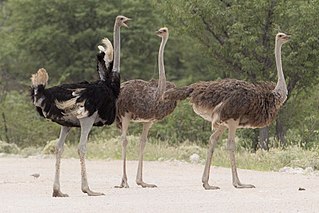
The common ostrich, or simply ostrich, is a species of flightless bird native to certain areas of Africa. It is one of two extant species of ostriches, the only living members of the genus Struthio in the ratite group of birds. The other is the Somali ostrich, which has been recognized as a distinct species by BirdLife International since 2014, having been previously considered a distinctive subspecies of ostrich.

Struthionidae is a family of flightless birds, containing the extant ostriches and their extinct relatives. The two extant species of ostrich are the common ostrich and Somali ostrich, both in the genus Struthio, which also contains several species known from Holocene fossils such as the Asian ostrich. The common ostrich is the more widespread of the two living species, and is the largest living bird species. The extinct genus Pachystruthio from the Late Pliocene-Early Pleistocene of Eurasia is one of the largest birds ever.

Genyornis newtoni is an extinct species of large, flightless bird that lived in Australia during the Pleistocene Epoch until around 50,000 years ago. Over two metres in height, they were likely herbivorous. Many other species of Australian megafauna became extinct in Australia around that time, coinciding with the arrival of humans. It is the last known member of the extinct flightless bird family Dromornithidae which had been part of the fauna of the Australian continent for over 30 million years. They are not closely related to ratites such as emus, and their closest living relatives are thought to be fowl.

Elephant birds are extinct flightless birds belonging to the order Aepyornithiformes that were native to the island of Madagascar. They are thought to have gone extinct around AD 1000, likely as a result of human activity. Elephant birds comprised three species, one in the genus Mullerornis, and two in Aepyornis.Aepyornis maximus is possibly the largest bird to have ever lived, with their eggs being the largest known for any amniote. Elephant birds are palaeognaths, and their closest living relatives are kiwi, suggesting that ratites did not diversify by vicariance during the breakup of Gondwana but instead convergently evolved flightlessness from ancestors that dispersed more recently by flying.

Flightless birds are birds that cannot fly, as they have, through evolution, lost the ability to. There are over 60 extant species, including the well-known ratites and penguins. The smallest flightless bird is the Inaccessible Island rail. The largest flightless bird, which is also the largest living bird in general, is the common ostrich.

Ostriches are large flightless birds. Two living species are recognised, the common ostrich, native to large areas of sub-Saharan Africa, and the Somali ostrich, native to the Horn of Africa.

Stegodon is an extinct genus of proboscidean, related to elephants. It was originally assigned to the family Elephantidae along with modern elephants but is now placed in the extinct family Stegodontidae. Like elephants, Stegodon had teeth with plate-like lophs that are different from those of more primitive proboscideans like gomphotheres and mammutids. Fossils of the genus are known from Africa and across much of Asia, as far southeast as Timor. The oldest fossils of the genus are found in Late Miocene strata in Asia, likely originating from the more archaic Stegolophodon, subsequently migrating into Africa. While the genus became extinct in Africa during the Pliocene, Stegodon persisted in South, Southeast and Eastern Asia into the Late Pleistocene.

Dromornithidae, known as mihirungs and informally as thunder birds or demon ducks, were a clade of large, flightless Australian birds of the Oligocene through Pleistocene epochs. All are now extinct. They were long classified in Struthioniformes, but are now usually classified as galloanseres. Dromornithids were part of the Australian megafauna. One species, Dromornis stirtoni, was 3 m tall. Only a single species, Genyornis newtoni survived into the Late Pleistocene. They are thought to have been herbivorous.
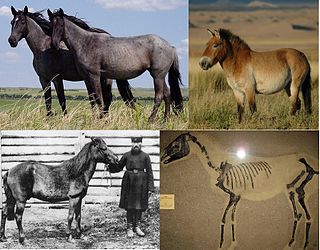
The wild horse is a species of the genus Equus, which includes as subspecies the modern domesticated horse as well as the endangered Przewalski's horse. The European wild horse, also known as the tarpan, that went extinct in the late 19th or early 20th century has previously been treated as the nominate subspecies of wild horse, Equus ferus ferus, but more recent studies have cast doubt on whether tarpans were truly wild or if they actually were feral horses or hybrids.

Archaeornithomimus is a genus of ornithomimosaurian theropod dinosaur that lived in Asia during the Late Cretaceous period, around 96 million years ago in the Iren Dabasu Formation.

Chilantaisaurus is a genus of large theropod dinosaur, possibly a neovenatorid or a primitive coelurosaur, from the Late Cretaceous Ulansuhai Formation of China. The type species, C. tashuikouensis, was described by Hu in 1964.

Aepyornis is an extinct genus of elephant bird formerly endemic to Madagascar. The genus had two species, the smaller A. hildebrandti and the larger A. maximus, which is possibly the largest bird ever to have lived. Its closest living relative is the New Zealand kiwi. They became extinct sometime around 1000 AD, probably as a result of human activity.

The Arabian ostrich, Syrian ostrich, or Middle Eastern ostrich is an extinct subspecies of the ostrich that lived on the Arabian Peninsula and in the Near East until the mid-20th century.
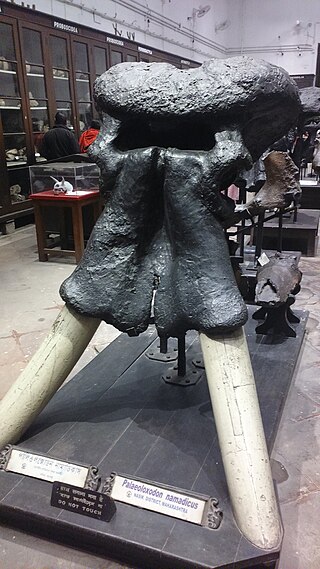
Palaeoloxodon namadicus is an extinct species of prehistoric elephant known from the Middle Pleistocene to Late Pleistocene of the Indian subcontinent, and possibly also elsewhere in Asia. The species grew larger than any living elephant, and some authors have suggested it to have been the largest known land mammal based on extrapolation from fragmentary remains, though these estimates are speculative.

The Asian or Asiatic ostrich, is an extinct species of ostrich that lived during the Neogene period on the Indian subcontinent.
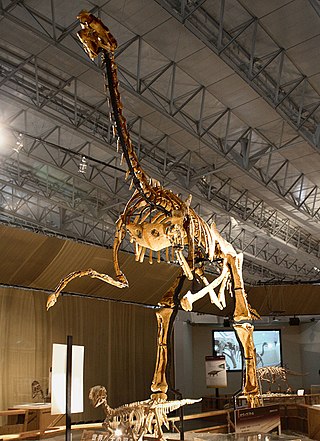
Gigantoraptor is a genus of large oviraptorosaur dinosaur that lived in Asia during the Late Cretaceous period. It is known from the Iren Dabasu Formation of Inner Mongolia, where the first remains were found in 2005.

Pachystruthio is a genus of extinct bird which lived in Eurasia from the Late Pliocene to the Middle Pleistocene. Its fossils have been found in Hungary, Greece Crimea, Georgia, and China. The genus contains three species: P. pannonicus, P. dmanisensis, and P. transcaucasicus, which were all formerly placed with the ostrich genus, Struthio. An incomplete femur from the Nihewan Formation (China) has been assigned to Pachystruthio indet. P. dmanisensis has been estimated standing 3.5 meters tall and weighing up to 450 kg (990 lb), making it much larger than the modern ostrich and one of the largest known birds.
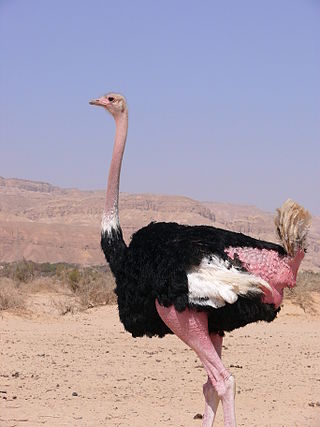
The North African ostrich, red-necked ostrich, or Barbary ostrich is the nominate subspecies of the common ostrich from West and North Africa. It has the largest average size among the subspecies of ostriches, making it the largest living bird.

















